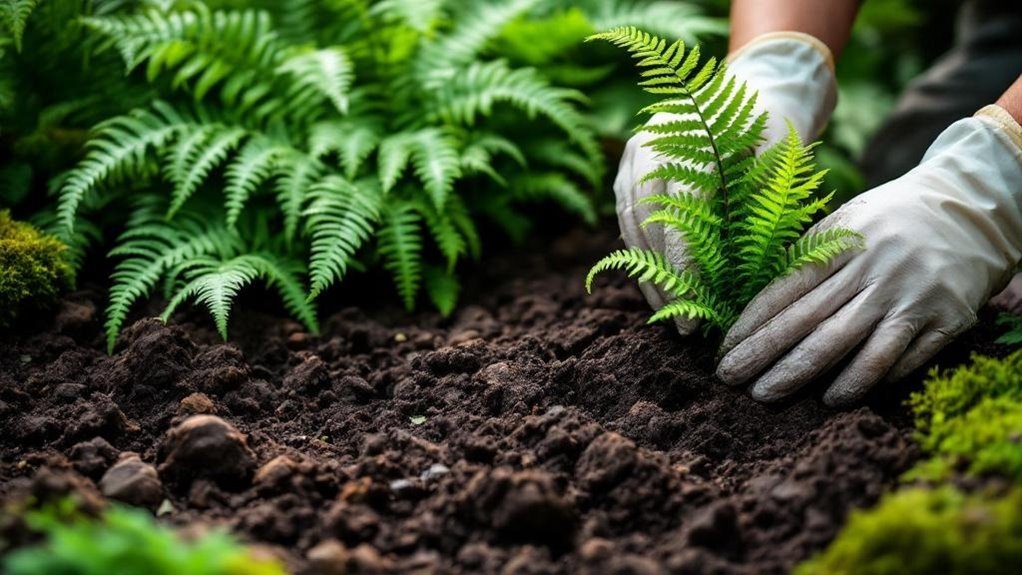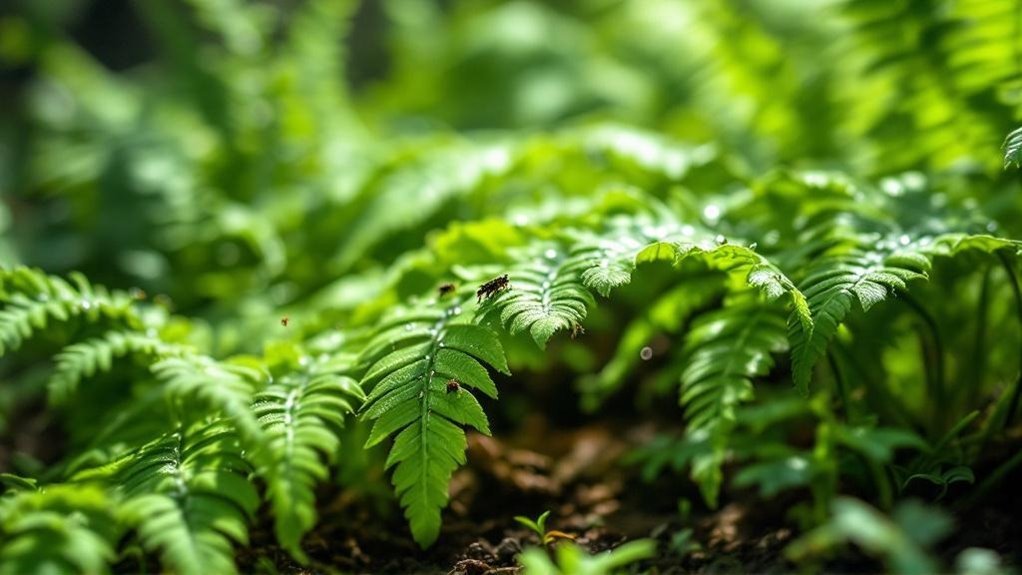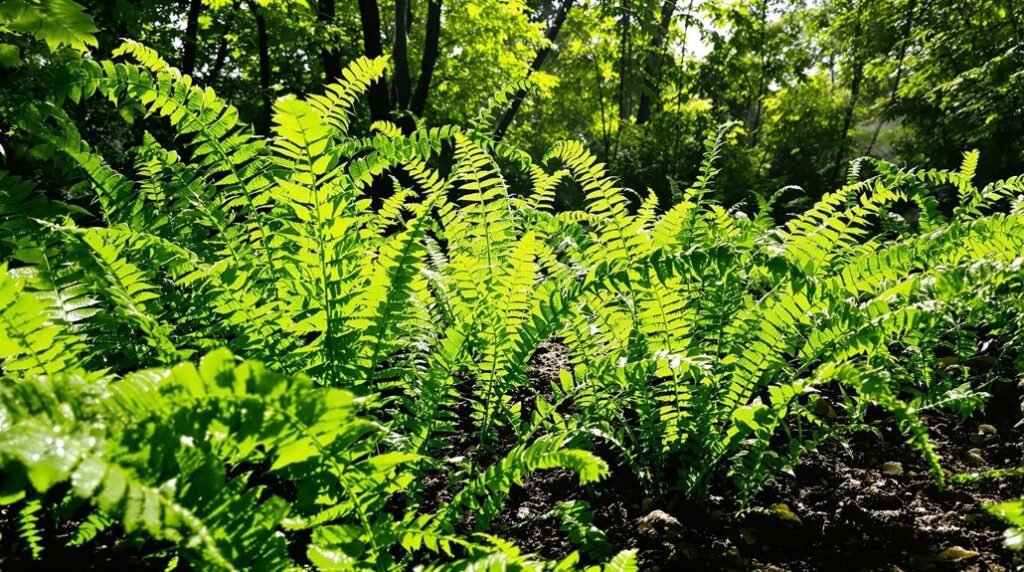Did you know that over 10,000 fern species thrive worldwide, many perfectly suited for shaded garden spots? If you want your shade garden to flourish, understanding how to care for these resilient plants is key. From choosing native varieties to mastering their watering needs, the right approach can transform your space into a verdant retreat. But before you start planting, there are crucial factors to take into account that make all the difference.
Selecting Native Fern Species for Shade Gardens
How do you choose the best native ferns for your shade garden? Start by considering popular native ferns like Lady Fern, Maidenhair Fern, Christmas Fern, and Cinnamon Fern, all well-suited for local climates and soils.
When growing ferns, focus on species adapted to the moist soil typically found in shade gardens, as this supports healthy growth. Evaluate each fern’s size, shape, color, and texture to match your garden’s aesthetic and space.
Cinnamon Fern, for example, tolerates partial sun, offering flexibility if your garden isn’t fully shaded. Understanding how native ferns grow—whether clumping or spreading—helps you plan your layout effectively.
Choosing the right native species guarantees your shade garden thrives with minimal effort and maximum beauty.
Understanding Light and Moisture Needs of Ferns
Although many ferns thrive in deep shade, you’ll find that some, like the Cinnamon Fern, can handle partial sun, so evaluating your garden’s light levels is key.
Ferns prefer environments with good air circulation to prevent fungal issues. To keep your ferns healthy, maintain evenly moist conditions without waterlogging the roots by planting them in well-drained soil. This balance helps avoid root rot while supporting steady growth.
Ferns also thrive in slightly acidic soil, which you can promote by adding organic matter like pine straw. Regularly check light and moisture levels since inadequate light causes weak fronds, and improper watering leads to wilting or yellowing.
Preparing Soil and Planting Techniques for Ferns

To prepare the perfect soil for your ferns, start by enriching it with plenty of organic matter like humus, peat moss, and rotted bark mulch.
Begin by enriching soil with humus, peat moss, and rotted bark mulch for thriving ferns.
This organic matter creates a rich soil environment that supports healthy growth and strong roots. When preparing soil, aim for slightly acidic conditions favored by most ferns; adding pine straw can help achieve this.
Choose a well-draining soil mix to avoid waterlogging, which can cause root rot. Mix organic material thoroughly to improve drainage and nutrient retention.
When planting, set your ferns at the same depth they grew in their containers, then water them well to help roots establish.
These planting techniques and the right soil preparation will guarantee your ferns thrive in lush shade gardens.
Maintenance Practices: Watering, Mulching, and Fertilizing
Since ferns thrive in consistently moist soil, you’ll want to keep the ground well-draining but rich in organic matter to avoid root rot and prevent the fronds from wilting.
Proper watering is crucial—keep soil moist but not soggy. Mulching with organic materials like shredded leaves or pine straw helps conserve moisture, control weeds, and maintain the acidic soil ferns prefer.
When it comes to fertilizing, use organic options such as manure or fish emulsion early in spring and apply balanced, slow-release fertilizers during the growing season.
Remember to water thoroughly before and after fertilizing to avoid leaf burn and enhance nutrient uptake.
Here’s a quick guide:
- Water consistently to keep soil moist but well-draining.
- Mulch to conserve moisture and improve soil acidity.
- Fertilize organically and regularly, adjusting for potted or basket ferns.
Managing Common Fern Pests and Diseases

Keeping your ferns healthy goes beyond watering, mulching, and fertilizing—you also need to watch out for pests and diseases that can damage their delicate fronds. Common problems include scale insects, which cause yellowing leaves but respond well to insecticidal soap or horticultural oil treatments.
Fungal diseases like rust thrive in damp conditions, so promoting good air circulation around your ferns helps prevent moisture buildup and infection. Avoid overwatering to reduce the risk of root rot—ensure soil drains well but remains consistently moist.
Nutrient deficiencies often show as yellow foliage; applying a balanced, slow-release fertilizer can restore health. By monitoring these issues closely and addressing them promptly, you’ll keep your ferns lush and thriving in your shade garden.
Enhancing Garden Design With Fern Growth Habits
When you understand how different ferns grow, you can design a garden that highlights their unique forms and textures. Ferns’ growth habits vary widely, so selecting the right types helps create depth and interest under dappled light.
To improve your garden design:
- Use long creeping ferns to create open, airy spaces that guarantee good air circulation.
- Add vase-forming ferns to introduce vertical accents, perfect for filling taller shade areas.
- Incorporate dense, short creeping native plants like Maidenhair Fern for lush ground cover.
Balancing these growth habits lets you build a rich tapestry of textures while managing spread.
Creating a Sustainable Habitat With Native Ferns
If you want to support local wildlife and promote ecological balance, incorporating native ferns like Lady Fern and Cinnamon Fern into your shade garden is a smart choice.
These native ferns thrive in organically rich, well-draining soil, helping you maintain moisture evenly throughout your garden. Their strong root systems prevent soil erosion and improve soil health.
When you plant bushy plants with good air circulation around them, you reduce disease risk and encourage healthy growth. Native ferns provide vital habitat for beneficial insects and pollinators, enhancing biodiversity.
Plus, their low-maintenance nature makes them ideal for sustainable landscaping. By choosing native ferns, you create a lush, thriving environment that supports local ecosystems while conserving resources.
Frequently Asked Questions
Can Ferns Thrive in Full Shade?
Yes, ferns can thrive in full shade. You’ll want to keep the soil moist, rich in organic matter, and well-draining. This environment prevents leaf scorch and helps ferns stay lush and healthy.
How to Keep Ferns Lush?
To keep your ferns lush, water them consistently with rainwater, mulch to retain moisture, plant in rich, well-draining soil, fertilize in spring with organic feed, and provide shade or filtered light to prevent leaf damage.
How Often Should I Water Ferns in the Shade?
You should water ferns in the shade when the top inch of soil feels dry, usually every few days. Use distilled or rainwater, watering early morning or late afternoon to keep soil evenly moist but not soggy.
Should I Cut off Brown Leaves on Fern?
Don’t let brown leaves weigh down your fern—cut them off at the base to keep it healthy and thriving. You’ll encourage fresh growth, improve air flow, and reduce disease risks with clean, sharp pruning shears.
Final Thoughts
By choosing native ferns and caring for them with attention to soil, moisture, and light, you’ll cultivate a shade garden that feels like a cool, green whisper in your yard. Keep their soil evenly moist, mulch regularly, and watch for pests to guarantee your ferns stay healthy and vibrant. With a little love and patience, your lush fern garden will grow into a peaceful retreat that breathes life into any shady spot.
